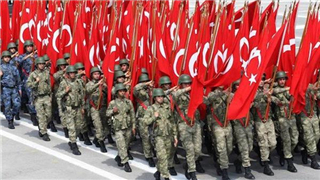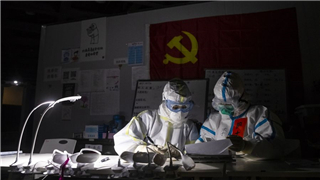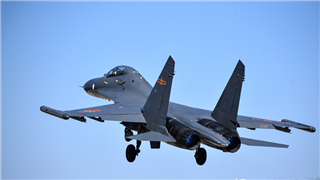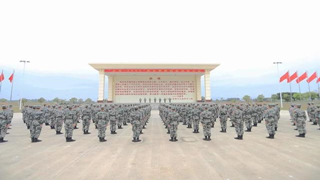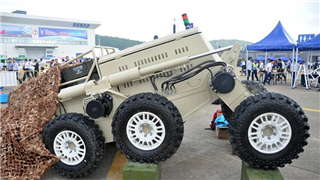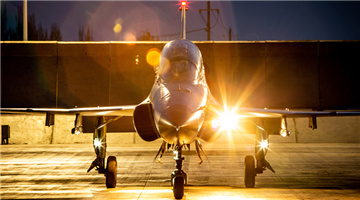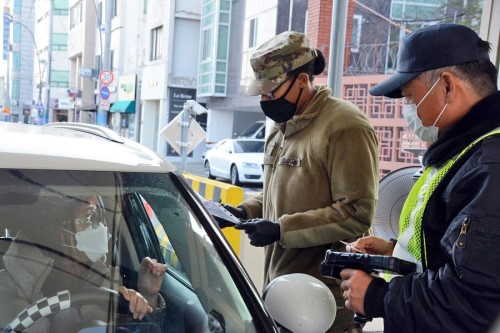
Pvt. Daija Gillam, 22, of the 25th Transportation Battalion, screens drivers before allowing them to enter Camp Walker in the coronavirus-hit city of Daegu, South Korea, Saturday, Feb. 22, 2020. (STARS AND STRIPES/KIM GAMEL)
By Wu Minwen
The spokesperson of the US Department of Defense (DoD) on March 16 said that DoD had reported 37 confirmed COVID-19 cases, including 18 service members, 13 dependants, 3 civilians and 3 contractors.
The US stations 27,500 service members, civil personnel and dependants in the ROK, who live at 87 bases and facilities across the country and rely on the ROK society to keep their life service facilities in normal operation. As of March 11, the ROK military had reported 38 confirmed COVID-19 cases, making 2,840 close contacts quarantined. On February 26, the first confirmed case occurred in American troops stationed in ROK, after which the US military shut down the schools, kindergartens and some other facilities at the overseas military bases of its Indo-Pacific Command (INDOPACOM), and the 23rd Chemical Battalion was ordered to carry out sterilization operations.
As the COVID-19 pandemic spread in Italy, an American sailor at the Naples base was confirmed COVID-19 on March 7, the first case in American troops in Europe. The sailor was then confined to his residence and received treatment.
The pandemic has significantly affected the military activities of American troops. On March 6, senior military officers from NATO, EU, and 17 other countries attended a US-led meeting at the U.S. Army Garrison Wiesbaden in Germany to discuss the upcoming Exercise Defender-Europe 20. On March 8, Italian army Chief of Staff General Salvatore Farina issued a statement on his COVID-19 confirmation and home quarantine. On March 10, Lt. Gen. Christopher Cavoli, commander of U.S. Army Europe, announced that he would conduct self-quarantine and work from home as he had close contact with General Salvatore Farina during the meeting in Germany.
The spokesperson of U.S. Army Europe announced on March 10 that the Exercise Defender-Europe 20 scheduled for April 20-May 20 may be rescheduled. The US-led joint exercise joined by 37,000 soldiers from 18 countries is planned to be held in Germany, Poland and the three Baltic Sea countries with a view to exercising America’s ability to project 20,000 soldiers to Europe. NATO Secretary-General Jens Stoltenberg called it “the largest deployment of US troops to Europe since the Cold War”. But the German Ministry of Defense announced on March 16 that Washington had decided to quit this exercise due to the COVID-19 outbreak.
On March 8, an American soldier stationed at a military base in the suburb of Virginia contracted COVID-19, the first case in the military on the American homeland. The infected marine just came back from a business trip overseas.
On March 16, a sailor assigned to the amphibious assault ship USS Boxer (LHD 4), which was berthing at the Port of San Diego then, tested positive for novel coronavirus. The sailor was immediately quarantined and all close contacts were asked to stay at home for observation. The US Navy announced a sterilization of the whole ship according to instructions from the Centers for Disease Control and Prevention (CDC) and the Navy Marine Corps Public Health Center.
Previously, the ROK-US Combined Forces Command (CFC) announced the postponement of various military exercises planned for the first half of this year. On March 8, the US Force Korea banned its service members and their dependants from traveling between the US and ROK due to the epidemic spread in ROK and its impacts on US troops there. The ban covers those who plan to return to the US after finishing their service in ROK and those scheduled to fly to the US for training and exchanges, and will last till May 6 at least.
The COVID-19 pandemic has also affected the top of the Pentagon. The DoD’s morning meeting shifts from assembly in one office to video conference in three offices
On March 12, the DoD announced that it would enact a 60-day ban on all service members, civil personnel and their dependants from traveling to or from countries that have a Warning - Level 3 Travel Health Notice (widespread, ongoing transmission), starting from March 13.
The US military has adopted a wide range of prevention and control measures after the COVID-19 outbreak The DoD issued the Force Health Protection Guidance— Department of Defense Guidance for Personnel Traveling During the Novel Coronavirus Outbreak memo and two supplements on January 30, February 7 and 25 successively. The documents were signed by the Secretary of Defense Mark Esper and delivered to the whole military through the service commanders, chairman of the Joint Chief of Staff, DoD officers, and organs to guide the military units in response to the outbreak.
Last month, Defense Secretary Mark Esper signed the Department of Defense Global Campaign plan for Pandemic Influenza and Infectious Diseases 3551-13 and appointed the U.S. Northern Command (USNORTHCOM) in charge of homeland defense to lead the plan The USNORTHCOM initiated a combat-ready mechanism after receiving the order, put all barracks in lockdown, and prioritized the safety of service members, military equipment and bases.
In the meantime, the United States Army Medical Research Institute of Infectious Diseases (USAMRIID), the medical lab of Walter Reed Army Institute of Research (WRAIR) and the United States Department of Health and Human Services (HHS) work together to develop the COVID-19 testing reagents and vaccines. On March 17, Washington announced that their COVID-19 vaccine started clinical test the previous day and the first anonymous volunteer had been vaccinated, to be joined by 45 more young and healthy volunteers. But the testing process may span 18 months.
A close look at the development of the COVID-19 pandemic that first broke out two months ago reveals that the world has come to a high-risk era of constant people flow and frequent occurrence of infectious diseases, which are the common challenge faced by all humanity. Military activities against the backdrop of epidemic prevention and control will perhaps become normal in the military build-up, training, and combat.
(The author is from the College of Information and Communication, PLA National University of Defense Technology)

